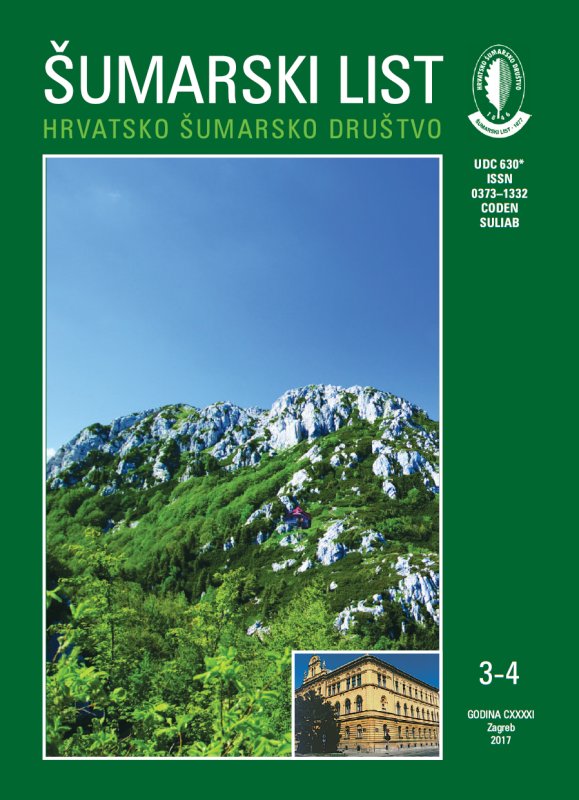
broj: 3-4/2017
pdf (15,8 MB) |
|
||||||||||||||
| RIJEČ UREDNIŠTVA | ||
| Uredništvo | ||
| WHAT, IF ANYTHING, HAS CHANGED? pdf HR EN | 113 | |
| IZVORNI ZNANSTVENI ČLANCI | ||
| Jelena KRANJEC, Marno MILOTIĆ, Marija HEGOL, Danko DIMINIĆ | UDK 630* 449 (001) https://doi.org/10.31298/sl.141.3-4.1 | |
| FUNGUS-LIKE ORGANISMS IN THE SOIL OF DECLINING NARROW-LEAVED ASH STANDS (Fraxinus angustifolia Vahl) pdf HR EN | 115 | |
| Summary Narrow-leaved ash (Fraxinus angustifolia Vahl), ecologically and economically very important species of Croatian lowland forests, has been showing more prominent symptoms of dieback in the past few years. Research conducted so far has confirmed presence of the pathogenic fungus Hymenoscyphus fraxineus Baral, Queloz & Hosoya in the crowns and stems of the trees showing the symptoms of dieback at several locations in Croatia (Diminić 2015, Milotić et al. 2016). Since forest dieback is usually a consequence of multiple abiotic and biotic factors, research to find causes often encompass not just the above-ground parts of stands, but also the root systems and soil, where fungal-like organisms such as Phytophthora species are considered to be an important biotic factor responsible for tree mortality. The goal of this research was to detect fungus-like organisms in the soil of declining narrow-leaved ash stands in order to confirm or reject the hypothesis that pathogenic Phytophthora species have a potential role in the dieback and also to expand the knowledge about fungus-like organisms’ diversity in Croatian forest soils. Total of 30 soil samples were collected from three forest management units (ten from each) in declining narrow-leaved ash stands, around the stems of trees of different health status according to Jankowiak et al. (2014). Fungus-like organisms were isolated using the soil baiting method according to Themann and Werres (1999), with Rhododendron catawbiense Michx. and Prunus laurocerasus L. leaves used as baits. Pure mycelia cultures showing vegetative morphological features characteristic for fungal-like organisms were obtained from 24 soil samples. To confirm this, sporangia production was induced in these isolates by flooding agar discs taken from 4-7 days old colonies with three different non-sterile soil extracts for each (1%, 1,5%, 5%). Sporangia were successfully induced in all isolates except one, which was chosen for the species identification using molecular methods together with five others (two isolates from each location). Genomic DNA was isolated using modified phenol-chloroform method according to Allemann et al. (1999). Amplification of internal transcribed spacers (ITS1 and ITS2) and 5.8 subunit of nuclear ITS rDNA region was conducted using the ITS4/ITS6 primer set, with reaction mixture and PCR protocol as in Grünwald et al. (2011). Amplification, PCR product purification and sequencing were conducted at InovaGen Ltd. (Zagreb, Croatia). All three isolates obtained from soil sampled around declining trees were identified as Phytopythium citrinum (B. Paul) Abad, De Cock, Bala, Robideau, Lodhi & Lévesque, and other three obtained from soil sampled around healthy trees were identified as Pythium lutarium Ali-Shtayeh, Pythium anandrum Drechsler and Phytopythium litorale Nechw. Presence of Phytophthora species in the soil of declining narrow-leaved ash stands wasn’t confirmed at the investigated locations, excluding them as one of the potential causative agents of narrow-leaved ash dieback in Croatia until further research is conducted. Although the Pythium and Phytopythium species were often isolated from the soil of declining forest stands and are known pathogens of seedling in forest nurseries, their possible role in dieback of narrow-leaved ash has yet to be determined. Key words: narrow-leaved ash; fungal-like organisms; soil; Pythium; Phytopythium | ||
| Ali DURKAYA, Birsen DURKAYA, Ali SABANCI, Sinan KAPTAN | UDK 630* 537 (001) https://doi.org/10.31298/sl.141.3-4.2 | |
| EVALUATION OF THE EFFECTS OF VARIOUS FACTORS ON ABOVEGROUND AND BELOWGROUND BIOMASS STORAGE CAPACITY OF EASTERN MEDITERRANEAN MAQUIS VEGETATION pdf HR EN | 123 | |
| Kyriaki KITIKIDOU, Elias MILIOS, Panagiota PALAVOUZI | UDK 630* 582 (001) https://doi.org/10.31298/sl.141.3-4.3 | |
| Development of an ensemble classifier with data from description sheets To classify forest stands in site qualities pdf HR EN | 131 | |
| PRETHODNO PRIOPĆENJE | ||
| Matija STERGAR, Klemen JERINA | UDK 630* 156 https://doi.org/10.31298/sl.141.3-4.4 | |
| WILDLIFE AND FOREST MANAGEMENT MEASURES SIGNIFICANTLY IMPACT RED DEER POPULATION DENSITY pdf HR EN | 139 | |
| Ljiljana KEČA, Milica MARČETA, Stjepan POSAVEC, Sreten JELIĆ, Špela PEZDEVŠEK-MALOVRH | UDK 630* 899 https://doi.org/10.31298/sl.141.3-4.5 | |
| MARKET CHARACTERISTICS AND CLUSTER ANALYSIS OF NON-WOOD FOREST PRODUCTS pdf HR EN | 151 | |
| IZVORNI ZNANSTVENI ČLANCI | ||
| Erhan ÇALIŞKAN, Uzay KARAHALIL | UDK 630* 686 + 383 (001) https://doi.org/10.31298/sl.141.3-4.6 | |
| EVALUATION OF FOREST ROAD NETWORK AND DETERMINING TIMBER EXTRACTION SYSTEM USING GIS: A CASE STUDY IN ANBARDAG PLANNING UNIT pdf HR EN | 163 | |


